The 7 rules of excubation
For years, corporations have been going after the holy grail of innovation. The challenge of finding the right approach has now become even tougher as digitization and lowered barriers-to-entry speed up and heat up the competition with greenfield start-ups that disrupt corporations’ existing business models. As intrapreneurship and incubators continue to fail, excubation could be the long wished-for solution to the innovation challenge.
In a nutshell, excubation is the smart separation of corporate exploitation and exploration endeavors. For exploration, new ventures are given access to existing corporate assets (client base, etc.) while also being allowed to bypass the typical limitations engrained in corporate conventions and processes. The “smartness” of this approach lies in ensuring a cohesive, tight exchange between the in- and out-flow of innovation.
Re-integration as the biggest challenge of corporation innovation
Separating corporate entrepreneurship activities too much or too little from the core business has been a hurdle for innovation success. Current approaches like intrapreneurship programs, corporate incubators or accelerators have been failing for this very reason, as innovation efforts were either suffocated by the core business or starved as an external start-up that could not be integrated because of culture and process divergence. Re-integration has so far been the biggest challenge for most corporate innovation approaches that – more often than not – has resulted in pure financial engagement of a corporation with a start-up firm and fallen short of the core purpose of corporate innovation.
The recurrent flow between execution and innovation entities, where innovative ideas are fed forward and new businesses are fed back, is the critical element of the excubation approach. It ensures that the innovation entity receives sufficient support and resources; more importantly, it ensures that a certain part of the execution DNA is incorporated into new ventures, which in return will make it much easier to re-integrate the venture once it has taken off.
Importantly, establishing your “excubator” does not immediately require creating and heavily funding a new legal entity. Running a pilot, start-up-like excubation project that successfully creates an innovative product or business model will provide valuable experience and help build a repeatable model for future innovations.
Excubation vs. other means of corporate entrepreneurship
Experience shows that, while there is not a clear pattern for companies choosing a given approach, the more traditional innovators (GE, 3M, Nordstrom, even tech companies like Qualcomm and Adobe) tend to experiment with intrapreneurship models, while smaller companies and players with less history in traditional innovation (Otto Group, ProsiebenSat1, Commerzbank, Bayer) more often run accelerator programs.
The term “excubation” is derived as a contraposition to “incubation”. Given this, start-ups are developed outside of the cooperation as opposed to being developed within the cooperation. Excubation aims for a better balance along a set of key parameters that can be grouped into “innovation level and source”, “anchoring within the organization” and “financial engagement”.
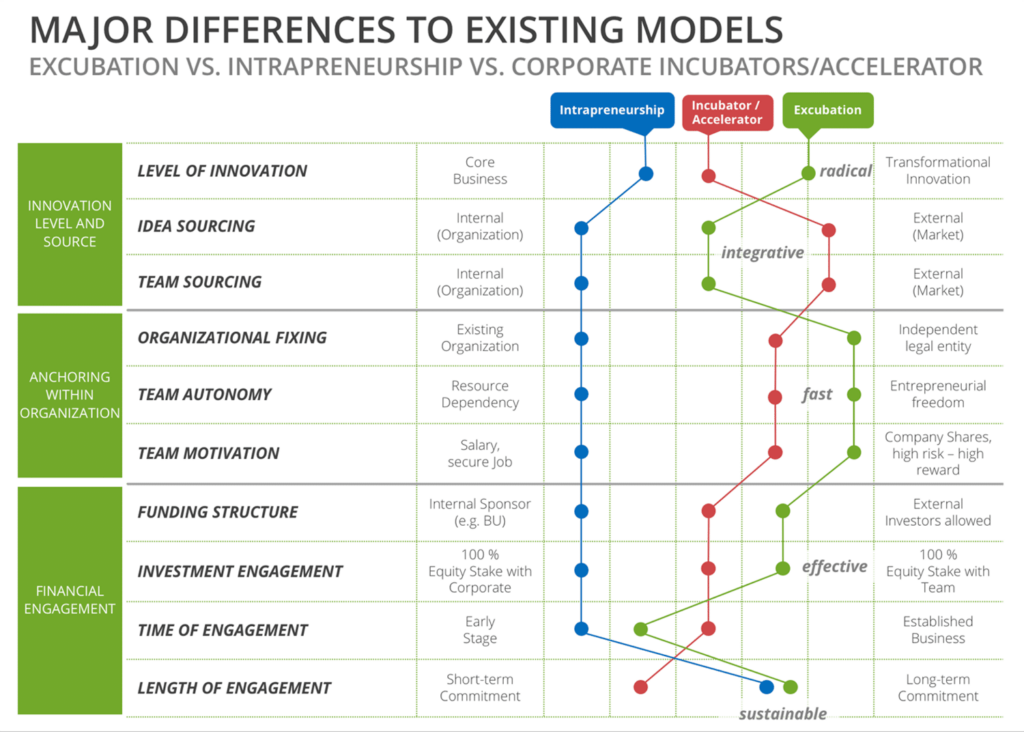
Excubation takes a more balanced approach to the sourcing of teams and ideas, leveraging internal and external resources synergistically. Regarding anchoring, the approach is more aggressive, offering more independence and decision authority for the start-up team, which is different from what is typically found in intrapreneurships and incubators. Looking at examples, you will find companies like Microsoft Techstars, BASF, SAP (Innowerft) and eon already running excubation-like approaches.
Boiling down the excubation approach into actionable and implementable elements, seven “rules” of corporation entrepreneurship for every corporation to follow, can be defined.
- Separate innovation from execution: Find a smart balance between moving the start-up closer vs. further away from the core business with respect to organization, processes and incentives.
- Attract entrepreneurial talent: Ensure availability of internal and external entrepreneurial talent with the right skill and will profile, set incentives for effective development of innovations.
- Facilitate innovation flow: Run an effective process for developing digital innovations, leverage corporate resources, give decision authority to the team, manage towards a tangible outcome.
- Manage innovation portfolio: Ensure a balanced portfolio of tangible digital business innovations with sufficient potential revenue contribution, comprised of the corporation’s own start-ups and external start-up investments.
- Inspire employees in the core business: Create a passion for corporate innovation activities and followership within the core employee base to trigger support and motivate potential intrapreneurs to partake in innovation activities.
- Educate employees: Provide training and education for employees in the core and innovation business, enabling them to get used to the day-to-day deployment of innovation methodologies and entrepreneurial thinking.
- Support idea flow: Ensure that sufficiently many and tangible new business ideas are generated from within and outside of the company.
While the implementation of these rules needs to be tailored to the starting point of the respective company, as a whole they outline the necessary, mutually reinforcing steps that serve as a reliable guideline for excubation.
RULE #1: SEPARATE INNOVATION FROM EXECUTION
One classic dilemma every successful organization faces is the challenge of delivering innovation beyond the core of its current business. While the current business is focused on execution and exploitation, innovation requires exploration and development of new competencies.
Corporate mechanisms and organizational structures generally do not allow for the fast and agile development of radical business model innovation. Therefore, the tasks of optimizing the core business and innovating new businesses need to be separated organizationally so that the respective units can tailor their approaches, processes and incentives specifically to these tasks.
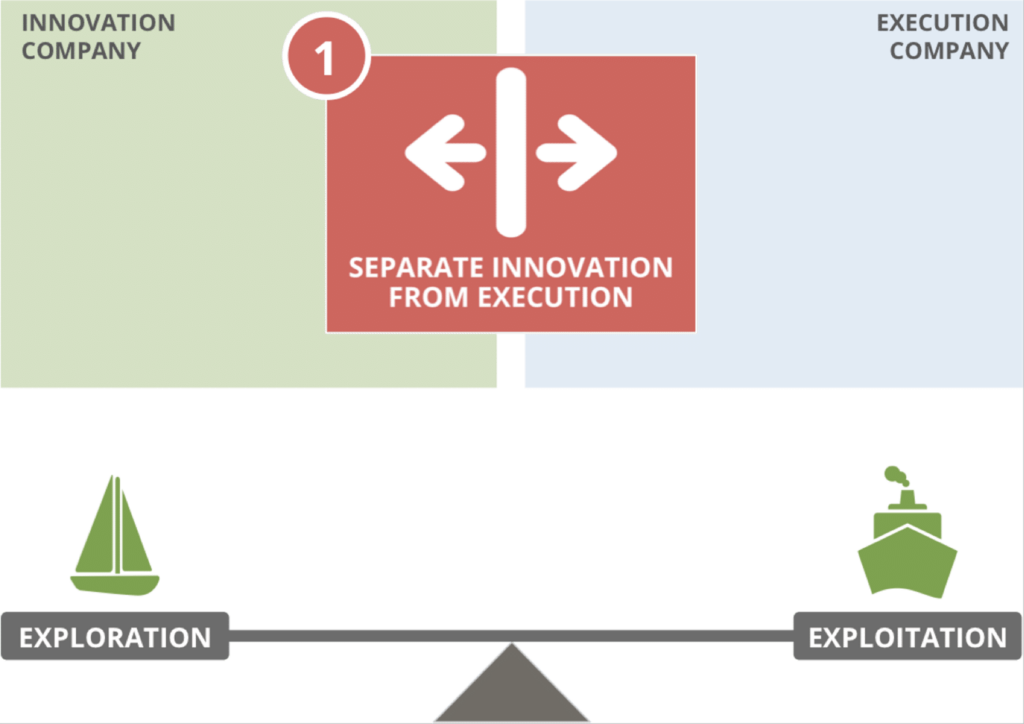
The excubation approach dives deeply into the relationship between the core business and the innovation unit to leverage the strengths of both. Within this model, two separate units can be identified: “execution company” (focusing on exploitation) and “innovation company” (focusing on exploration), sometimes set up as an individual legal entity.
The core of the problem
Many companies using traditional approaches to building ventures find themselves facing a set of practical challenges. For instance, since assets are tailored to execute the existing business model, innovation venture “access” to it could become an inflexible liability. As a result, internal ventures fight on two fronts, balancing their needs with the needs of the core company. And at the same time, strategic and resource dependency leaves the new business at the company’s mercy. In light of these challenges, it becomes clear that using a smart approach to separation is critical, given that neither fully external nor fully internal venturing approaches have been sufficiently yielding meaningful results for corporates. With internal venturing, synergetic benefits between the core company and the venture are typically overestimated and are most often not achieved, as experience shows.
Finding the right level of separation
To find the right level of separation, the core business and the new venture should be looked at from three different angles (see the figure below). This helps us evaluate how close the two are in terms of strategic success factors (management capabilities, operating capabilities and proprietary assets that both the new venture and the core business make use of), their business models (synergies and risks) and the capacity to innovate and scale.

RULE #2: ATTRACT ENTREPRENEURIAL TALENT
Google, aka Alphabet, is already a very valuable company, but it could have been even more valuable had it been able to retain the entrepreneurial talent that left the company to found Instagram, Pinterest and Twitter. But Google – as innovative and entrepreneurially driven as it is – didn’t manage to provide an environment compelling enough to keep these founders in-house.

Outside a company, and even more so within a company, there is a limited number of entrepreneurially talented people with the right skill / will profile for successfully building new businesses. Statistics show that only up to 10-15% of employees fit these requirements. It is equally important to identify and to incentivize this talent the right way and to combine it to build the most effective teams.
Three motivators for entrepreneurs
In each company, there is a group of entrepreneurially minded people who have gained significant work experience and would like to found their own company. However, many do not find a way to transition from their fixed job into an entrepreneurial role or lack the right idea, the team and / or financial support. By consequence, each company needs to set up a recurring mechanism to identify those talented individuals, bring them into a community of like-minded people and link them with compelling corporate start-up ideas. To operationalize this, companies can apply a model called “corporate founders club”.
There are typically three important motivators for potential entrepreneurs: ownership and decision responsibility, effective boundary conditions (access to resources, technology, IP, processes) and financial upside in line with the success of the business. The challenge for a company is to design these elements carefully in a way that is beneficial for both the core business and the venture.
Entrepreneurs want to move fast and make quick decisions on their own responsibility. This is what they find in greenfield start-ups and what companies need to enable too, by modeling a start-up environment. Separate team, separate budget, separate processes and separate location, yet intelligently supported by the company with resources, people and expertise and guided by a disciplined process – this is at the core of the excubation approach.
Defining incentives and participation models
Creating a startup-like incentive model is both extremely difficult but actually also quite easy for a corporate – if it is approached with the right mindset.
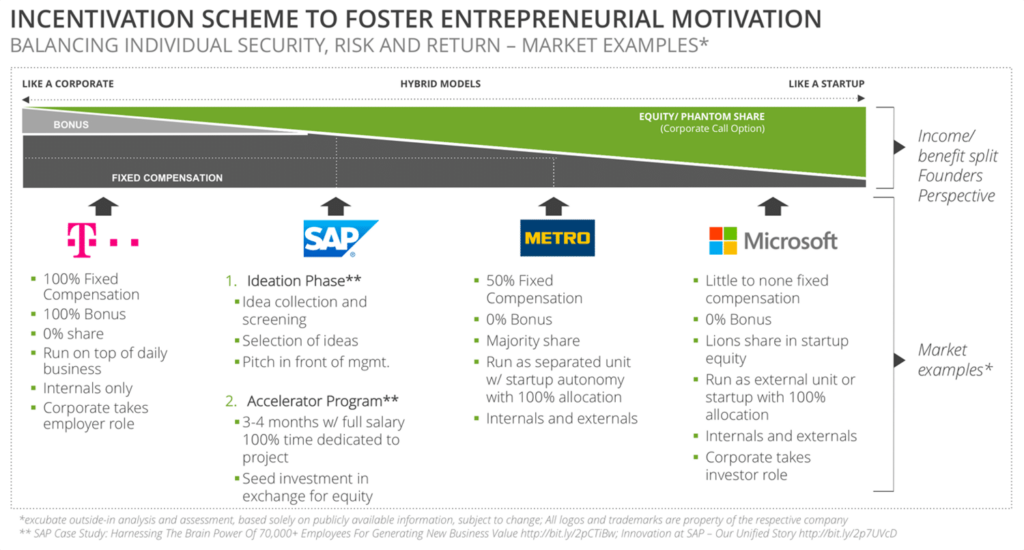
Entrepreneurs, depending on their own lifecycle stage, need to balance financial security with financial upside and are not necessarily only driven by the latter. However, it is crucial to build at least some form of financial participation model into the incentives structure, either by giving the entrepreneur an equity share or an equity equivalent (phantom shares).
Big companies – in contrast to greenfield startups – have additional options to create a compelling value proposition that pure start-ups don’t have and that put corporates in an even better position: additional fixed salary, additional perks or the option to return to their original job position should the start-up not work out. The latter, however, might be questioned from a motivational perspective and could create a too laid-back perspective (“burn your boats” approach).
RULE #3: FACILITATE INNOVATION FLOW
For a corporate entrepreneurship approach to be successful, the innovation flow and the innovation development process need to be thoroughly facilitated. It occurs just too often that corporate entrepreneurship programs define the starting point and end point of an innovation process, but are not clear and disciplined enough on the process, go/no-go milestones, activities and deliverables in-between. Thus, the third excubation rule “Facilitate Innovation Flow” addresses this issue and defines best practices for running the innovation process within a corporate innovation company, sufficiently facilitated by the execution organization.

The objective of this rule is to generate a competitive advantage via providing ideal conditions for the start-up to move faster and more effectively than others. The key questions to be addressed at this stage by both the execution and innovation company are:
- How can innovation teams be supported most effectively to enable quick development and validation of their business models?
- How can mentoring be defined along all stages of the innovation process?
- What tracking mechanisms can be established for fast decision making, access to core business strengths, networks, and sales / delivery resources?
- How can time-to-market be reduced, and the competitiveness of innovation development be maximized?
Facilitation is needed on two levels
Effective facilitation of the innovation flow happens on two levels – macro-level (basic support) and micro-level (specific execution support). The macro-level is all about accelerating access to resources which the innovation company needs to be successful, such as access to materials, experts, technologies, customers and intellectual property, functional support such as HR, finance, legal support, free budget, and mentoring from senior players in the enterprise.
A pragmatic way to establish this is to assign individual people within the execution company’s HR, finance, legal departments to quickly support the new ventures. Based on this, a growing support system within the execution company will emerge, knowing and understanding the new venture activities of the innovation company and facilitating the innovation flow in an optimum way.
Support on the micro-level, in turn, focuses on an output-oriented process for developing individual innovations and business models. This is significantly different from existing product development processes within corporates and follows a few key paradigms.
- Fail fast, fail cheap
- Trial-and-error
- Fake it before you make it
- Go for what’s good enough
- Two steps forward – one back
- Start qualitative, end quantitative
These paradigms are at first sight straightforward, but are actually hard to implement in a corporate setup.
RULE #4: MANAGE THE DIGITAL INNOVATION PORTFOLIO
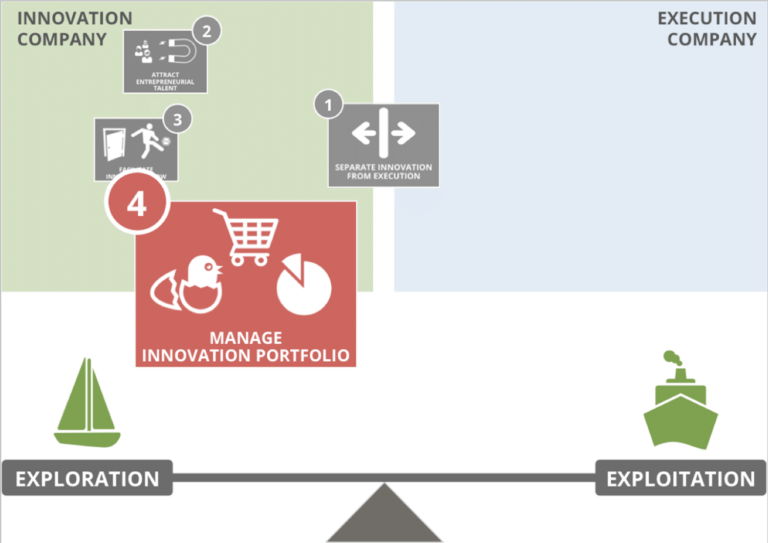
Being successful with digital corporate innovation requires a well thought-through approach to managing a digital innovation portfolio. It consists of the right type, number and magnitude of innovations. Experience shows that managing a portfolio of 10 – 15 digital innovation businesses, each having the potential to contribute a single digit percentage to corporate revenue, is a reasonable task: this is a good number. However, it is important to underline that it is not enough to limit portfolio management to the innovation itself. To get digital innovation portfolios right, it is necessary to attract and retain talent, i.e. to incubate, acquire or invest not just in new ideas, but primarily in entrepreneurial talent and digital capabilities.
Getting the right portfolio composition makes the difference
The innovation portfolio should comprise three portfolio components, each with a suggested budget allocation: own innovations, developed in a start-up-like approach (50% of the budget); acquisitions of external start-ups that fit the digital innovation approach (20%); and co-investments in existing start-up companies (30%). The innovation portfolio needs to represent an effective mix of core-related, adjacent and transformational innovations and the respective talent behind them. To define those ideal proportions, a clear scoping in line with the enterprise’s business and digital strategy is essential. It helps to avoid unfocused activity.
Measuring the success of the innovation portfolio should follow a pragmatic, yet structured approach along a set of simple performance indicators and criteria, such as:
- Input: financial investment and time effort in relation to ideas developed
- Throughput: number and quality of ideas run through the portfolio
- Output: number / share of innovations eventually hitting the market
- Leadership: intensity of management attention and entrepreneurial freedom given
- Competence: share of employees and intrapreneurs being trained as innovators
- Entrepreneurial climate: extent to which entrepreneurial behavior is encouraged
- Balance: relation of different types, risk profiles and time horizons of innovations
Selection and preparation of ideas and talent
It’s critical to evaluate project and business ideas along a crisp set of clearly defined criteria before including them in your innovation portfolio. Similarly, it is also crucial to select the right talent and team along with the idea, since only the combination of both will deliver success. Typical criteria for an idea with substantial value creation potential that should be considered when filling the portfolio funnel are novelty of the idea, uniqueness of the value proposition, sustainability of the potential business, timing, business potential and scalability, as well as strategic fit with the core business strategy and valuation potential five to ten years after initial investment.
Equally, if not more, important than selecting the right idea is selecting the right team for which a set of criteria should be applied, based on longer term experience with founder teams. Such criteria include, to name a few: vision, ambition, passion for being and acting like an entrepreneur, availability of skills and experiences, ability to focus on value creation and benefits for customers, not only technology, as well as flexibility and self-reflation to assume feedback and pivot the business model if needed, and, last but not least, chemistry and an effective working mode between the founding team members.
ULE #5: INSPIRE EMPLOYEES
As the recent PwC benchmark study has shown, over 60% of corporate executives consider their employees their most important partners in innovation. It is thus crucial to inspire employees in the core business to partake in innovation activities. The main objective is to win entrepreneurial talent from within the company. In corporate practice, a few key measures are typically employed to achieve this:
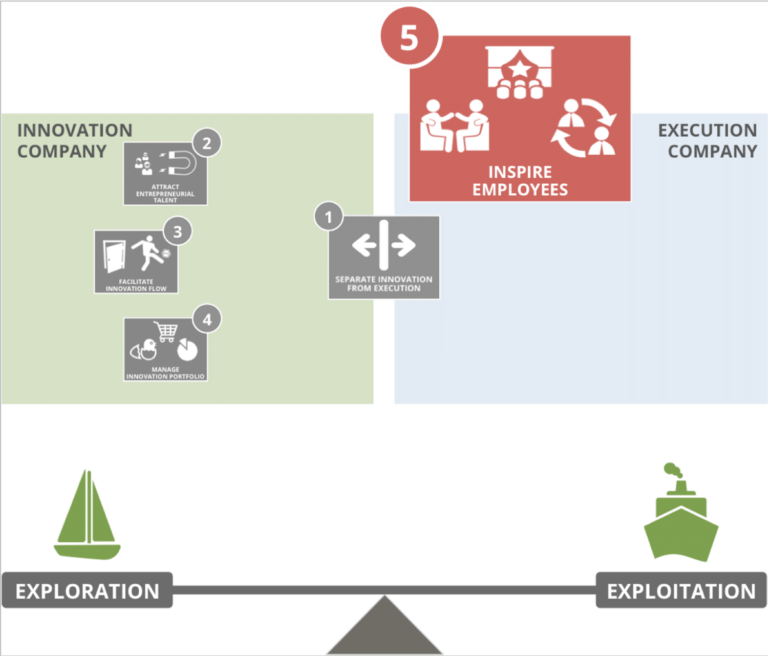
Job rotation
Allowing employees to take over a different role for a while, enables them to look at things from a new perspective and to think out of the box. This can be facilitated virtually, e.g. in an intranet forum, or as actual job-swapping. An example for a virtual job rotation is a forum where employees discuss what they would do differently if they were the CEO of the corporate.
A more disruptive approach is releasing the employees from their day-to-day business for a pre-defined period of time, e.g. three months, to work in a startup and learn new and agile methods and working styles. Another example is sending off the corporate’s finance employees to take over the CFO position of a startup for a week and deal with different financial challenges for a change.
But job rotation also works the other way around: by bringing in external startup CXOs onto the corporate management team or into relevant boards of the execution company, the decision-makers can be inspired by new perspectives and opinions on old problems.
Connection of employees within the startup community
Startup events and fairs are an inspiring source to keep up-to-date on latest technologies and developments from a startup perspective. Sending employees off to those events helps them to get connections within the startup community. Furthermore, internal roadshows and TED talks can be organized to present new technologies and research results or the latest innovative business models from the innovation company.
Rule breaking
A more radical approach is the reduction of implemented rules and guidelines, like working hours and location, process adherence, and corporate identity guidelines. For example, in some cases it may be stimulating to offer flexible workspaces instead of having fixed offices and working desks. This enables a better exchange and communication between the employees and may lead to a more fertile and productive environment.
Furthermore, awards such as “Employee of the Month” should be abandoned, as those are just tools to reward those who “stick to the rules”.
It is fairly easy to put these measures in place in a larger corporate context and leverage this activity as a communication vehicle to bring the larger employee base on board. As with all start-up activities, a “minimum viable” approach is more effective than a perfectly set-up inspiration program that takes long lead times. Trying things out and tailoring them over time already puts the leadership team into the right mindset.
RULE #6: EDUCATE EMPLOYEES
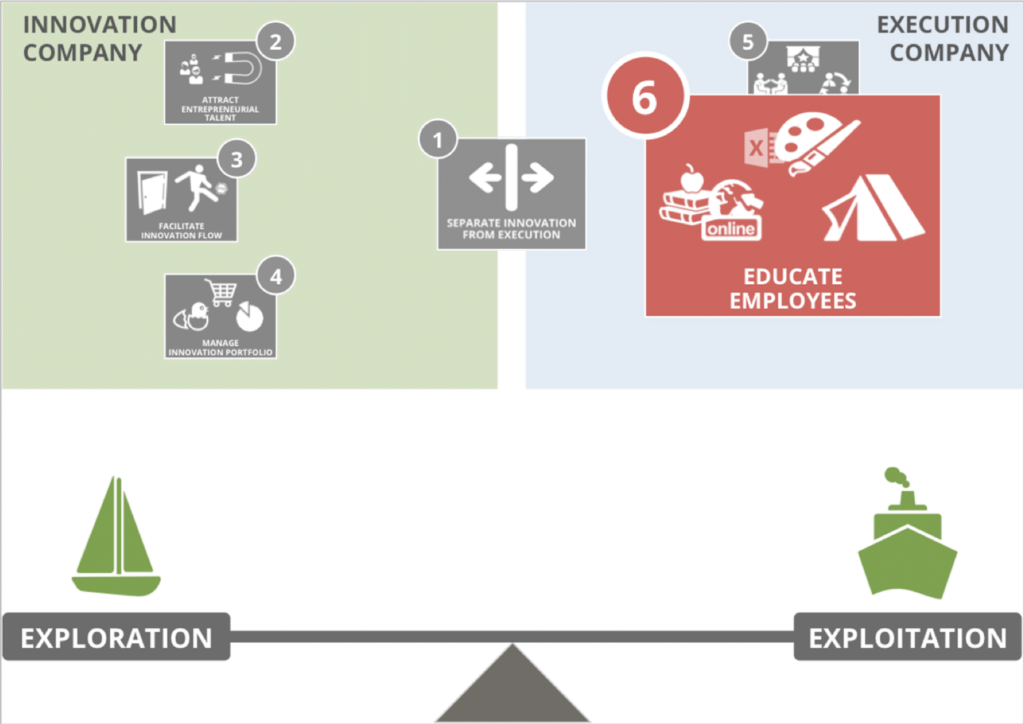
Besides the inspiration of the core company’s employees, their education in start-up and innovation-related matters is necessary for the development of entrepreneurial talent. Teaching employees core methodologies and approaches for developing radical innovations equips the 5-15% entrepreneurially minded people in the organization to participate in corporate start-up activities. To achieve this, a few key activities can be deployed comfortably in parallel to the core business.
Start-up library
The implementation of a physical or virtual startup library can be used as a platform for employees to get more information on startup-related topics, to share notes and to discuss developments with colleagues. Online resources like webinars, forums, open online courses (MOOCs) can be used to train employees.
Fablabs for experimentation
Fablabs are work spaces and workshops where employees can develop prototypes and mockups for their product ideas. Simple tools and basic materials are often sufficient to transport the product idea and discuss potential features. Apps like POP (Prototyping on Paper) are great tools to visualize first drafts for mobile apps and websites.
Co-working spaces
Co-working spaces can be used to foster collaboration activities between startups and the corporate’s employees. Offering work space to startups that work on a technology or topics that are relevant for the core business does not only bring important knowledge into the company’s ecosystem. It also creates a disruptive work environment and can be used to hold workshops and events.
Quarterly boot camps
Boot camps are 2-3 day events where employees develop and pitch new ideas. The results (ideas and teams) can then be channeled into the innovation company.
The opportunities are almost limitless. All that is needed is to provide some structured guidance to those interested in innovation methodologies to equip them with the basics. It is not about following a textbook approach (and there are many) or having employees take all kinds of courses and gather certificates in design thinking. Applying the learning, and making things real, is crucial.
RULE #7: SUPPORT INNOVATION FLOW
The implementation of a physical or virtual startup library can be used as a platform for employees to get more information on startup-related topics, to share notes and to discuss developments with colleagues. Online resources like webinars, forums, open online courses (MOOCs) can be used to train employees.
The objective of this rule is to secure a constant flow of innovative ideas from the core company into the innovation company. As the core company and its employees are faced with basic elements of the core company’s business model on a daily basis, ideas on how to substantially improve and ideally disrupt the business may also come from these sources. To support employees in identifying and bringing forward innovative ideas, a few measures should be implemented:
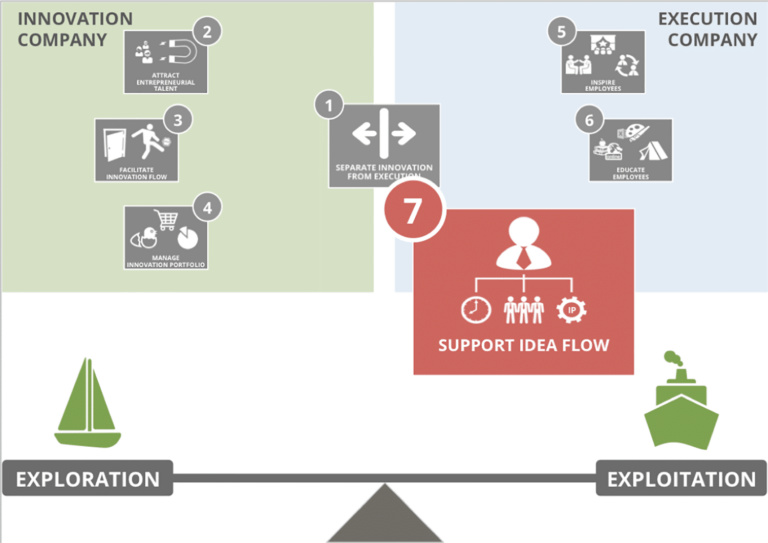
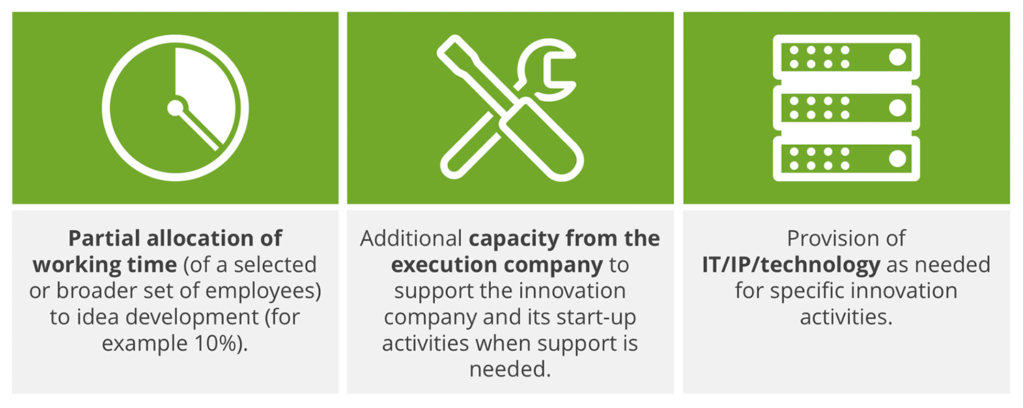
Overall this rule is about enabling the innovation activities as effectively as possible and ensuring a sufficient leverage of the capabilities and capacities available in the execution company. It is that support, after all, that creates the strategic advantage of a corporate start-up over a greenfield start-up and that increases the probability of the start-up’s success from the often cited 10% to 20-30%.
For more information, experience and an individual approach for your corporate innovation makeover, talk to Excubate: innovate@excubate.de



